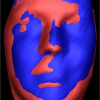Free Online Productivity Tools
i2Speak
i2Symbol
i2OCR
iTex2Img
iWeb2Print
iWeb2Shot
i2Type
iPdf2Split
iPdf2Merge
i2Bopomofo
i2Arabic
i2Style
i2Image
i2PDF
iLatex2Rtf
Sci2ools
ICPR
2004
IEEE
2004
IEEE
3D Shape-based Face Recognition using Automatically Registered Facial Surfaces
In this paper, we address the use of three dimensional facial shape information for human face identification. We propose a new method to represent faces as 3D registered point clouds. Fine registration of facial surfaces is done by first automatically finding important facial landmarks and then, establishing a dense correspondence between points on the facial surface with the help of a 3D face template? aided thin plate spline algorithm. After the registration of facial surfaces, similarity between two faces is defined as a discrete approximation of the volume difference between facial surfaces. Experiments done on the 3D RMA dataset show that the proposed algorithm performs as good as the point signature method, and it is statistically superior to the point distribution model?based method and the 2D depth imagery technique. In terms of computational complexity, the proposed algorithm is faster than the point signature method.
| Added | 09 Nov 2009 |
| Updated | 09 Nov 2009 |
| Type | Conference |
| Year | 2004 |
| Where | ICPR |
| Authors | Berk Gökberk, Lale Akarun, M. Okan Irfanoglu |
Comments (0)

